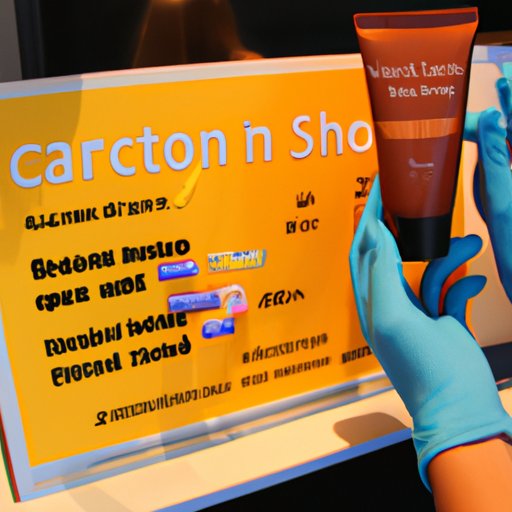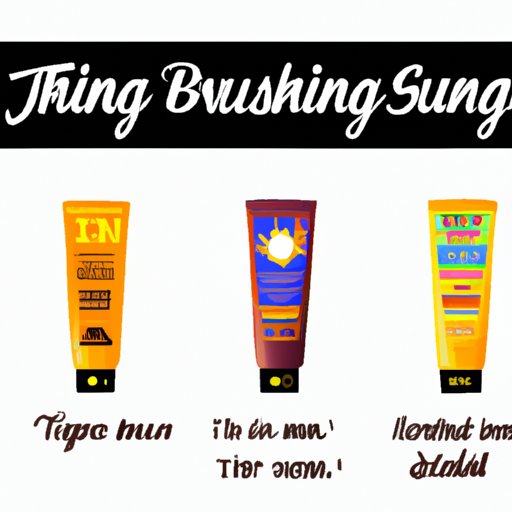Introduction
Tanning lotion is a product designed to help people achieve a tanned look without having to expose their skin to the sun or tanning beds. It contains a combination of ingredients that work together to darken the skin and give it a golden hue. The purpose of this article is to explore the science behind tanning lotions and how they work to achieve a tan.

Exploring the Science Behind Tanning Lotions
Before exploring how tanning lotions work, it’s important to understand the science behind tanning in general. Tanning occurs when the skin is exposed to ultraviolet (UV) radiation from the sun or a tanning bed. This UV radiation triggers the production of melanin, a pigment that gives skin its color. The more melanin produced, the darker the skin will appear.
The role of melanin in tanning is important because it helps protect the skin from further damage by absorbing some of the UV radiation. In addition, melanin also plays a role in determining how quickly a person tans. Those with darker skin usually take longer to tan than those with lighter skin, as they already have higher levels of melanin in their skin.
What Ingredients are Found in Tanning Lotions?
Tanning lotions typically contain a variety of ingredients, including moisturizers, bronzers, accelerators and sunscreens. Moisturizers help keep the skin hydrated, while bronzers provide an immediate bronzing effect. Accelerators stimulate the production of melanin, which helps speed up the natural tanning process, and sunscreens protect the skin from further damage from UV radiation.
Different types of tanning lotions are available on the market. Some are designed for indoor use, while others are specifically formulated for outdoor tanning. There are also special tanning lotions designed for certain skin types, such as dry or oily skin.
How Does Tanning Lotion Work to Achieve a Tan?
Tanning lotion works by increasing melanin production, which helps darken the skin and give it a golden hue. The ingredients in the lotion help to accelerate the natural tanning process, allowing you to achieve a tan faster than if you were to just expose your skin to the sun alone.
The accelerators in tanning lotions help to increase the production of melanin, which in turn helps darken the skin. The moisturizers in the lotion also help to keep the skin hydrated, which can help prevent the skin from becoming too dry and flaky.
Dangers of Using Tanning Lotions
Despite the benefits of using tanning lotions, there are also potential risks associated with them. Excessive exposure to UV radiation can lead to skin damage and even skin cancer. Additionally, some of the ingredients in tanning lotions may be irritating to the skin or cause allergic reactions.
It’s important to remember that a tan is not a healthy alternative to sun protection. In fact, wearing sunscreen is still the best way to protect your skin from harmful UV rays.

Tips for Choosing the Right Tanning Lotion
When choosing a tanning lotion, it’s important to read the list of ingredients and make sure it doesn’t contain any irritants or allergens. Additionally, it’s a good idea to choose a product that contains sunscreen, as this will help protect your skin from further damage.
You should also consider your skin type when selecting a tanning lotion. Those with dry skin should opt for a lotion that is more hydrating, while those with oily skin should look for a product that is oil-free.
Conclusion
Tanning lotions are widely used to achieve a tanned look. This article has explored the science behind tanning lotions, the ingredients they contain and how they work to achieve a tan, as well as the potential dangers associated with using them. When choosing a tanning lotion, it’s important to read the ingredients list and select a product that is suitable for your skin type. Additionally, it’s also important to remember to wear sunscreen to protect your skin from further damage.
(Note: Is this article not meeting your expectations? Do you have knowledge or insights to share? Unlock new opportunities and expand your reach by joining our authors team. Click Registration to join us and share your expertise with our readers.)
